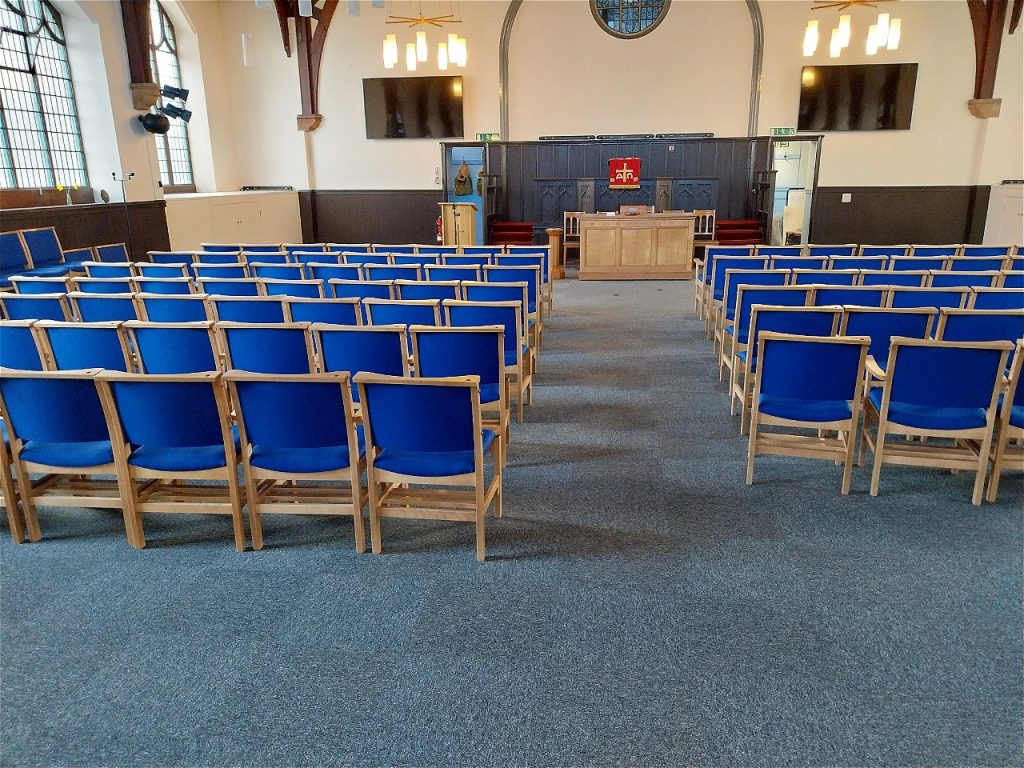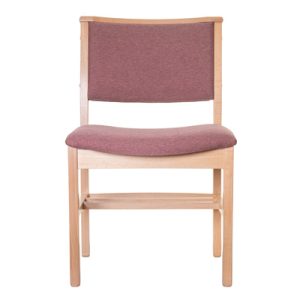
How to Set Out Church Chairs Safely and Legally in the UK
A Practical Guide for Churches of All Denominations
Whether you’re fitting out an Anglican, Catholic, Baptist, Methodist, or Free Church, getting your seating layout right is essential. It affects not only how your space feels but also how it functions — from capacity and comfort to safety and legal compliance.
This guide explains how to set out your church chairs safely, legally, and practically, based on British standards and fire regulations. It includes key measurements, accessibility tips, and layout examples to help you create a welcoming and compliant worship space.
1. Chair Spacing and Row Configuration
Correct chair placement can optimise both comfort and capacity:
- Chair-to-Chair Spacing: For maximum capacity, place chairs directly beside each other. For a more open feel, leave 50 mm (2 inches) between each.
- Row Spacing (Back-to-Back):
- Minimum: 915 mm (36 inches) allows the congregation to shuffle sideways to their seat.
- Improved Comfort: 965 mm (38 inches) gives people the ability to walk directly to their seat.
- Optimal Access: 1020 mm (40 inches) provides space to pass someone seated or standing.
- Chair Linking: Chairs should be linked in sets of 4–12, especially in large venues, to comply with fire safety best practice and prevent trip hazards.
2. Aisle Widths and Access
Proper aisle spacing ensures smooth movement and safe evacuation:
- Centre Aisle: Recommended width is 1.2 to 1.5 metres (4–5 feet).
- Side Aisles: Minimum width is 800 mm (2 ft 7 in); 1 metre or more is preferred in larger churches.
- Exit Access: All aisles must lead directly to clearly marked exits, which should remain unobstructed at all times.
3. Accessibility (Equality Act 2010)
Churches have a legal and moral obligation to provide inclusive seating:
- Wheelchair Spaces: Integrate these into the main seating area, not at the back or off to one side.
- Turning Space: Provide a 1.5 m x 1.5 m clear turning circle near exits and doors.
- Mobility Access: Aisles must be at least 900 mm wide to accommodate wheelchairs and other mobility aids
4. Fire Safety and Legal Requirements
Under the Regulatory Reform (Fire Safety) Order 2005, churches must meet fire safety standards:
- Occupancy: Allow around 0.5 m² per seated person.
- Escape Routes: Keep all exit paths free from obstructions at all times.
- Chair Linking: Strongly recommended for all loose chairs to reduce hazards in an emergency.
- Historic Buildings: In listed churches, consult your fire risk assessor and heritage officer early in the design process.
5. Listed and Historic Churches
If your church is listed (Grade I, II*, or II), any changes to layout or furniture may require formal permission:
- Church of England: Apply for a Faculty through your diocese.
- Historic England: Offers detailed advice on making respectful, reversible changes.
- Free Churches: Often have internal heritage processes — always seek early guidance.
6. The York Deluxe Wooden Upholstered Chapel & Church Chair
The York Deluxe Wooden Church Chair (Winscombe Furniture Ltd) blends traditional design with modern comfort and is commonly used across UK churches. Here’s how to lay it out according to UK standards:
- Standard Spacing: 36” (915 mm) back-to-back — ideal for maximising capacity.
- Comfort Option: 38” (965 mm) for easier access to seats.
- Spacious Option: 40” (1020 mm) allows individuals to pass by one another comfortably, ideal for services with frequent movement or elderly congregations
7. Final Thoughts
Church seating isn’t just about aesthetics — it’s about function, safety, compliance, and community. This guide is designed to help all denominations plan layouts that are welcoming, legal, and comfortable.
Before finalising:
- Test a sample layout with your congregation
- Consult your local fire risk assessor
- Seek permissions early for listed sites
Winscombe Furniture Ltd
If you’re looking for compliant church seating, our York Deluxe Wooden Upholstered Chapel & Church Chair offers timeless looks with modern comfort and safety features.
We’re here to help guide you through layout planning, heritage sensitivity, and compliance with confidence.



